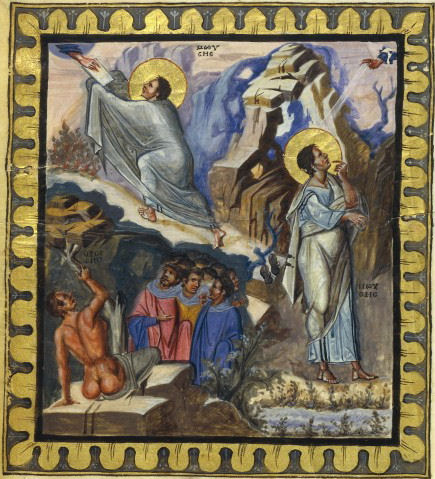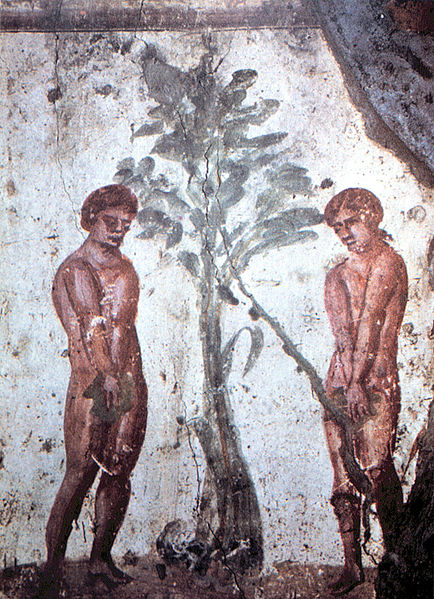 1.) The Tablets of the Law are semi-flat rounded off rectangles.
1.) The Tablets of the Law are semi-flat rounded off rectangles.While it had become common to depict the Tablets of the Law as rounded off rectangles, this is actually a recent innovation in Western art, becoming prevalent only from the late Medieval period. A majority of earlier depictions of the Tablets depict them as being rectangular slabs (see image at left, and here, here, here, here, and here for some more examples).
Rabbinic tradition, meanwhile, has it that the Tablets were either shaped like perfect cubes or sharp-cornered rectangles, six tefachim - a tefach ("handbreath") is approximately equal to 8 centimeters or 3.2 inches - in length and three tefachim thick (Baba Batra 14a).
 2.) Adam and Eve ate an apple.
2.) Adam and Eve ate an apple.There is nothing in the Bible that expressly mentions or suggests that the Tree of Knowledge of Good and Evil (Etz ha-Daat tov V'ra) is an apple tree. Even early authorities disagreed on the species of the tree and its fruit. The apocryphal Book of Enoch (32:4) suggests that the tree looked like a species of tamarind that bore fruit which resembled extremely fine grapes.
In the Talmud (Berachot 40b), Rabbi Meir said that Man and Woman debased themselves by drinking wine made out of the grape(s) which grew from the tree, "since the thing that most causes wailing to a man is wine" (as it did to Noah, who drank to the point of intoxication). Meanwhile, Rabbi Nehemiah suggested that the fruit may have been figs (cf. Genesis 3:7, where Adam and Eve sew fig leaves to hide their nakedness) while Rabbi Yehuda said that it was a sort of wheat (Hebrew khitah, a pun on khet, "sin"), "since a child does not know how to call 'father' and 'mother' until it has had a taste of corn."
The citron (Hebrew etrog, which resembles the Aramaic m'ragag, "desirable"; cf. Genesis 3:6) and the carob (since its Hebrew name charuv puns on cherev "sword", and churban "destruction") have also been suggested. Islamic tradition, meanwhile, commonly represents the fruit as a fig or olive.
Around the 12th century, Christian art in France and Germany started to depict the apple as the forbidden fruit, while Byzantine and Italian artists stuck with the belief that the Fruit of Knowledge was a fig. It was not until the later Renaissance that the "forbidden fruit=apple" belief was universal.
There are varying hypotheses on why the apple was chosen to represent this fruit, but one possible theory is that because the Latin word for evil, "malus", is homonymous with the word for apple: Adam and Eve contracted malus (evil) by eating a malus (apple).
3.) Golgotha was a skull-shaped hill with three tall crosses in it.
 While the word Golgotha does mean "the place of the skull," the place's appearance needn't necessarily have looked like a skull; indeed this belief that Golgotha is named so because of its appearance is only recent, dating only from the 19th century.
While the word Golgotha does mean "the place of the skull," the place's appearance needn't necessarily have looked like a skull; indeed this belief that Golgotha is named so because of its appearance is only recent, dating only from the 19th century.The general belief from early Christian times onwards is that the reason why it is called such is either because of its function as a place of execution, i.e. there were bones and skulls of victims strewn about all over the place, or the belief held by many Church Fathers that Adam was buried on that spot (Origen in the 2nd century, who himself have lived in Jerusalem for 20 years, is our earliest witness to this tradition).
No early Christian writer explicitly suggested that Calvary was a skull-shaped hill, and the Gospels themselves are silent as to whether Jesus' crucifixion occurred on a raised place at all. It is true that the tradition embodied in the name "Mount Calvary" appears as early as the 4th century, but that the hill was skull-like in form is quite a modern idea. In fact, St. Epiphanius of Salamis in the 4th century expressly said that "There is nothing to be seen on the place resembling this name; for it is not situated upon a height that it should be called (the place) of a skull, answering to the place of the head in the human body."
Gordon's Calvary (named after Major-General Charles George Gordon, who had popularized the site in 1882-83, after Otto Thenius of Dresden proposed this hill as the true location of Golgotha in 1842) does resemble a skull and is popular among some Christians as the location of Jesus' crucifixion. Even so, the features of the hill that make it look like a skull were most likely not present in the 1st century. Archaeologists believe it to be a quarry or mine developed only in the past two or three centuries; its skull-like appearance is thus due to modern mining or quarrying operations in the area.
Also, many works of art and even a number of films show only three crosses on Golgotha; sometimes shown as very tall ones.
However, it is more historically plausible that Golgotha was literally dotted with upright beams (stipes) on which the crossbeam (patibulum) was placed to make a cross - it was, after all, an execution site, and crucifixions by the tens or hundreds were most likely held there daily. It might be even possible that there were other crucified victims, dead or dying, in Golgotha when Jesus and the two criminals arrived.
Also, crosses were not that high; in fact, they were most probably only a feet or so from the ground, so as to facilitate wild animals consuming the corpses of the victims hanging thereon (victims of crucifixion were often left to hang on their crosses to rot or, at worst, were dumped in the garbage heap; giving a crucifixion victim a proper burial was rare and was the exception to the rule).
Early artworks (once again, examples are here, here, here, here, here, here, and here) quite uniformly depict the crosses as only a few measures tall than the victim. It was not until later that a number of artists gradually started increasing the heights of the crosses in their art. The end results of this were the popular images of three crosses which at most are somewhere around seven to ten-feet tall, standing on a hill very much devoid of anything else.

No comments:
Post a Comment